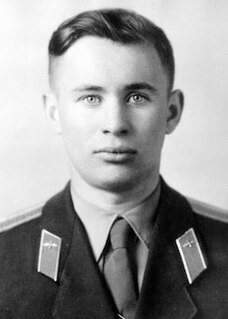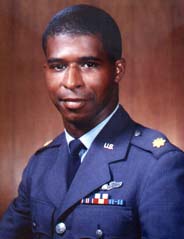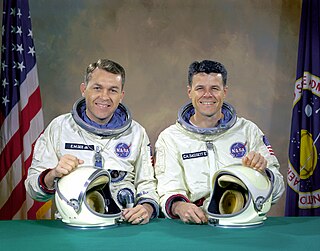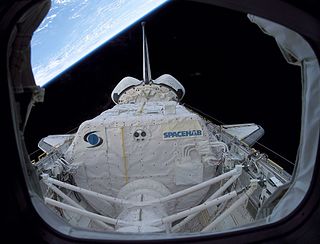 W
WThis article lists verifiable spaceflight-related accidents and incidents resulting in human fatality or near-fatality during flight or training for crewed space missions, and testing, assembly, preparation or flight of crewed and robotic spacecraft. Not included are accidents or incidents associated with intercontinental ballistic missile (ICBM) tests, fatality or injury to test animals, uncrewed space flights not resulting in human fatality or serious injury, or Soviet or German rocket-powered aircraft projects of World War II. Also not included are alleged unreported Soviet space accidents, which are considered fringe theories by a majority of historians.
 W
WMichael James Adams was an American aviator, aeronautical engineer, and USAF astronaut. He was one of twelve pilots who flew the North American X-15, an experimental spaceplane jointly operated by the Air Force and NASA.
 W
WCharles Arthur Bassett II, Major, USAF, was an American electrical engineer and United States Air Force test pilot. He went to Ohio State University for two years and later graduated from Texas Tech University. He joined the Air Force as a pilot and graduated from both the Aerospace Research Pilot School and the Air Force's Experimental Test Pilot School. Bassett was married and had two children. He was selected as a NASA astronaut in 1963 and was assigned to Gemini 9. He died in an airplane crash during training for his first spaceflight. He is memorialized on the Space Mirror Memorial; The Astronaut Monument; and the Fallen Astronaut memorial plaque, which was placed on the Moon during the Apollo 15 mission.
 W
WValentin Vasiliyevich Bondarenko was a Soviet fighter pilot selected in 1960 for training as a cosmonaut. He died as the result of burns sustained in a fire during a 15-day low-pressure endurance experiment in Moscow. The Russian government concealed the death, along with Bondarenko's membership in the cosmonaut corps, until 1980. A crater on the Moon's far side is named after him.
 W
WTheodore Cordy "Ted" Freeman, was an American aeronautical engineer, U.S. Air Force officer, test pilot, and NASA astronaut. Selected in the third group of NASA astronauts in 1963, he was killed a year later in the crash of a T-38 jet, marking the first fatality among the NASA Astronaut Corps. At the time of his death, he held the rank of captain.
 W
WGordo was one of the first monkeys to travel into space. As part of the NASA space program, Gordo, also known as Old Reliable, was launched from Cape Canaveral on December 13, 1958, in the U.S. PGM-19 Jupiter rocket on its AM-13 mission. The rocket would travel over 1,500 miles and reach a height of 310 miles (500 km) before returning to Earth and landing in the South Atlantic. A technical malfunction prevented the capsule's parachute from opening and, despite a short search, neither his body nor the vessel were ever recovered.
 W
WIntelsat 708 was a telecommunications satellite built by the American company Space Systems/Loral for Intelsat. It was destroyed on 15 February 1996 when the Long March 3B launch vehicle failed while being launched from the Xichang Satellite Launch Center in China. The launch vehicle veered off course immediately after liftoff and struck a nearby village, officially killing at least six people.
 W
WLeonid Grigoriyevich Ivanov was a member of Soviet Air Force Cosmonaut Training Group 6. He graduated from Higher Air Force School, Kachinsk, in 1971.
 W
WVladimir Mikhaylovich Komarov was a Soviet test pilot, aerospace engineer, and cosmonaut. In October 1964, he commanded Voskhod 1, the first spaceflight to carry more than one crew member. He became the first Soviet cosmonaut to fly in space twice when he was selected as the solo pilot of Soyuz 1, its first crewed test flight. A parachute failure caused his Soyuz capsule to crash into the ground after re-entry on 24 April 1967, making him the first human to die in a space flight.
 W
WOleg Grigoriyevich Kononenko was a member of Soviet cosmonaut group LII-1. He was born in the village of Samarskoye, in Rostov, Russia, then part of the Soviet Union. He graduated from Zhukovsky Air Force Institute in 1975. On July 12, 1977, he was selected for cosmonaut training as a pilot of the Buran space shuttle. He survived an aircraft ejection on the Soviet aircraft carrier Minsk on December 27, 1979. Kononenko was married three times and had four children. He was killed on September 8, 1980, in the crash of a Yakovlev Yak-38 VTOL fighter on takeoff from the Minsk in the South China Sea.
 W
WRobert Henry Lawrence Jr. was a United States Air Force officer and the first black astronaut.
 W
WThe 1966 NASA T-38 crash occurred when a NASA Northrop T-38 Talon crashed at Lambert Field in St. Louis, Missouri, on February 28, 1966, killing two Project Gemini astronauts, Elliot See and Charles Bassett. The aircraft, piloted by See, crashed into the McDonnell Aircraft building where their Gemini 9 spacecraft was being assembled. The weather was poor with rain, snow, fog, and low clouds. A NASA panel, headed by the Chief of the Astronaut Office, Alan Shepard, investigated the crash. While the panel considered possible medical issues or aircraft maintenance problems, in addition to the weather and air traffic control factors, the end verdict was that the crash was caused by pilot error.
 W
WThe Nedelin catastrophe or Nedelin disaster was a launch pad accident that occurred on 24 October 1960 at Baikonur test range, during the development of the Soviet R-16 ICBM. As a prototype of the missile was being prepared for a test flight, an explosion occurred when the second stage engine ignited accidentally, killing an unknown number of military and technical personnel working on the preparations. Despite the magnitude of the disaster, news of it was suppressed for many years and the Soviet government did not acknowledge the event until 1989. The disaster is named after Chief marshal of Artillery Mitrofan Ivanovich Nedelin, who was killed in the explosion. As commanding officer of the Soviet Union's Strategic Rocket Forces, Nedelin was the head of the R-16 development program.
 W
WElliot McKay See Jr. was an American engineer, naval aviator, test pilot, and NASA astronaut.
 W
WSoyuz 1 was a crewed spaceflight of the Soviet space program. Launched into orbit on 23 April 1967 carrying cosmonaut colonel Vladimir Komarov, Soyuz 1 was the first crewed flight of the Soyuz spacecraft. The flight was plagued with technical issues, and Komarov was killed when the descent module crashed into the ground due to a parachute failure. This was the first in-flight fatality in the history of spaceflight.
 W
WSoyuz 11 was the only crewed mission to board the world's first space station, Salyut 1. The crew, Georgy Dobrovolsky, Vladislav Volkov, and Viktor Patsayev, arrived at the space station on 7 June 1971 and departed on 29 June 1971. The mission ended in disaster when the crew capsule depressurised during preparations for reentry, killing the three-man crew. The three crew members of Soyuz 11 are the only humans to have died in space.
 W
WThe Space Mirror Memorial, which forms part of the larger Astronauts Memorial, is a National Memorial on the grounds of the John F. Kennedy Space Center Visitor Complex on Merritt Island, Florida. It is maintained by the Astronauts Memorial Foundation (AMF), whose offices are located in the NASA Center for Space Education next door to the Visitor Complex. The memorial was designed in 1987 by Holt Hinshaw Pfau Jones, and dedicated on May 9, 1991, to remember the lives of the men and women who have died in the various space programs of the United States, particularly those of NASA. The Astronauts Memorial has been designated by the U.S. Congress "as the national memorial to astronauts who die in the line of duty".
 W
WThe Scaled Composites Model 339 SpaceShipTwo (SS2) is an air-launched suborbital spaceplane type designed for space tourism. It is manufactured by The Spaceship Company, a California-based company owned by Virgin Galactic.
 W
WSTS-51-L was the disastrous 25th mission of the United States Space Shuttle program, the program to carry out routine transportation for Earth-to-orbit crew and cargo; as well as the final flight of Space Shuttle Challenger.
 W
WSTS-107 was the disastrous 113th flight of the Space Shuttle program, and the 28th and final flight of Space Shuttle Columbia. The mission launched from Kennedy Space Center in Florida on 16 January 2003 and during its 15 days, 22 hours, 20 minutes, 32 seconds in orbit conducted a multitude of international scientific experiments.
 W
WThe 2003 Alcântara VLS accident was an accident during the Brazilian Space Agency's third attempt to launch the VLS-1 rocket, which was intended to launch two satellites into orbit. The rocket exploded on its launch pad at the Alcântara Launch Center, killing 21 people.
 W
WVSS Enterprise was the first SpaceShipTwo (SS2) spaceplane, built by Scaled Composites for Virgin Galactic. As of 2004, it was planned to be the first of five commercial suborbital SS2 spacecraft planned by Virgin Galactic. It was also the first ship of the Scaled Composites Model 339 SpaceShipTwo class, based on upscaling the design of record-breaking SpaceShipOne.
 W
WThe VSS Enterprise crash occurred on October 31, 2014, when the VSS Enterprise, a SpaceShipTwo experimental spaceflight test vehicle operated by Virgin Galactic, suffered a catastrophic in-flight breakup during a test flight and crashed in the Mojave Desert near Cantil, California. Co-pilot Michael Alsbury was killed and pilot Peter Siebold was seriously injured.
 W
WClifton Curtis "C.C." Williams, Jr., was an American naval aviator, test pilot, mechanical engineer, major in the United States Marine Corps, and NASA astronaut, who was killed in a plane crash; he never went into space. The crash was caused by a mechanical failure in a NASA T-38 jet trainer, which he was piloting to visit his parents in Mobile, Alabama. The failure caused the flight controls to stop responding, and although he activated the ejection seat, it did not save him. He was the fourth astronaut from NASA's Astronaut Group 3 to have died, the first two having been killed in separate T-38 flights, and the third in the Apollo 1 fire earlier that year. The aircraft crashed in Florida near Tallahassee within an hour of departing Patrick AFB.